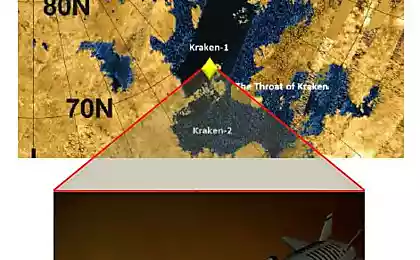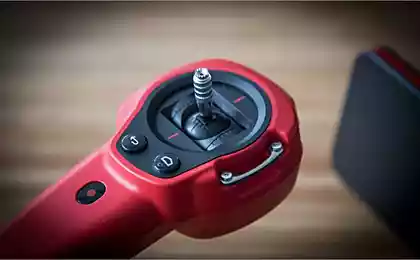
This week, there were two pieces of news from NASA, both associated with the Titan, Saturn's moon.
First , scientists have modeled the smell that people could feel the atmosphere of Titan
Second, in the bowels of NASA ponders the concept quadrocopter designed to search for traces of prebiotic chemicals.
What smells on Titan? H4> NASA created a chemical compound that could explain the orange-brown color of Titan's atmosphere. Through this experiment, the researchers were able to pinpoint the substance included in the hazy atmosphere of Saturn's moon.
"Now we can say that this compound has a strong aromatic character. This allows you to better understand the complex molecular composition of fog enveloping Titan, "says Melissa Trainer (Melissa Trainer), a planetary scientist from Space Flight Center Goddard .
This chemical compound has previously been detected infrared spectrometer apparatus "Cassini". In order to determine its composition, the researchers mixed in a container different gases. The idea of the experiment was that if a set of gases and environmental conditions are chosen properly, the result of a chain of chemical reactions in the tank creates an environment similar to the composition of Titan's atmosphere. This approach is akin to trying to determine the cake recipe to taste a slice cut from it.
The hardest part of this experiment was to a very small number of restrictions. Orange Titan gives a mixture of hydrocarbons and nitriles. But the family of hydrocarbons already includes hundreds of thousands of known compounds belonging to the minerals on Earth. And there may be a potentially even more.
Logical starting point to start with two gases, the most common on Titan: nitrogen and methane. But the attempts have resulted in a mixture with the corresponding spectrum. Encouraging results were obtained when the researchers added a third component. First, benzene was added, and subsequently a number of other substances are also found in the atmosphere of Titan, and related to the subfamily of aromatic hydrocarbons.

Best results were achieved by using aromatic hydrocarbons containing nitrogen. According to its spectral composition of the resulting mixture was sufficiently close to that registered the "Cassini". If we talk specifically about the smell, the scientists believe that it is mostly a specific sweet smell benzene < / a>.
"Titan's atmosphere consists of a zoo molecules. Combining measurements and laboratory experiments, we can better understand this satellite ».
We are going to conduct an experiment on the use of small (& lt; 10 kg) quadrocopter that can run from a balloon or ground unit. Its tasks will close photographing surface mapping, landing and taking samples of microscopic solid and liquid substances and their delivery to the ship carrier. Quadrocopter should be rechargeable.
Previous studies have demonstrated the feasibility of air flight on Titan and for larger vehicles, weighing up to 400 kg. But none of the studies have been conducted for testing I have described above tasks and scenarios.
We have developed a concept quadrocopter made possible by recent advances in miniaturization and autonomous navigation sensors, processors and samplers. All this also allows you to significantly enhance the ability of research and other types of vehicles. B>
For ground unit has been possible to carry out detailed studies of large areas around the landing site, mikrosёmka and sampling. In the case of landing near the lake, theoretically one unit could take samples and solid and liquid substances.
For balloon has been possible to carry out studies and surface sampling from the atmosphere without the need for subsequent touchdown. Blockquote>
Of course, the idea of using quadrocopter long been used in science fiction, but a real research astronautics it sounds very bold. Matties believes that small inexpensive drones would be useful not only in the study of Titan. Imagine what would Curiosity carried on a pair of quadrocopter. How much would it enhanced the rover to study the surrounding surface.
Source:























